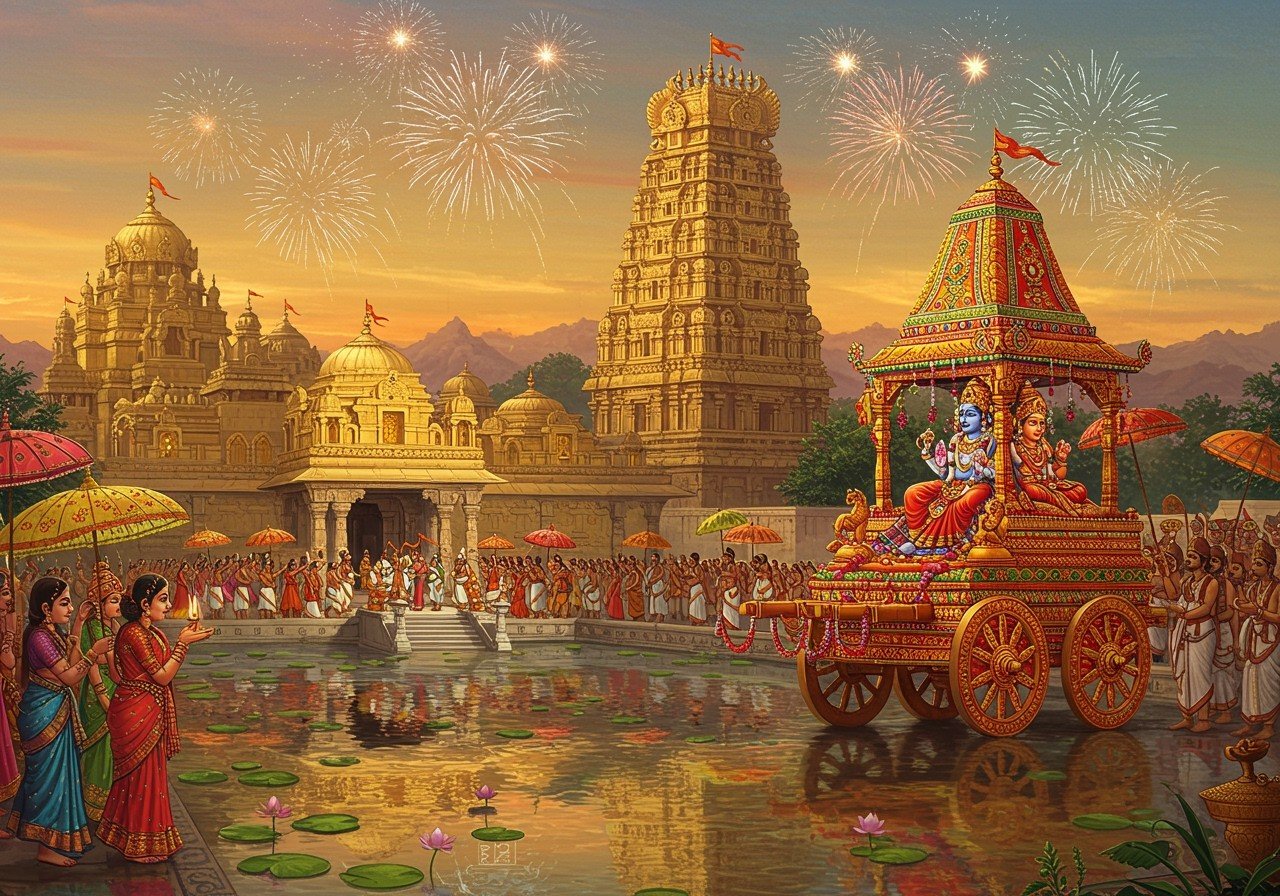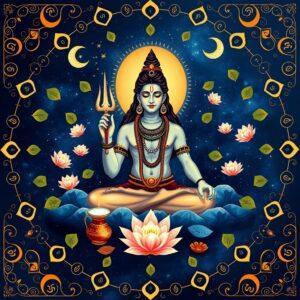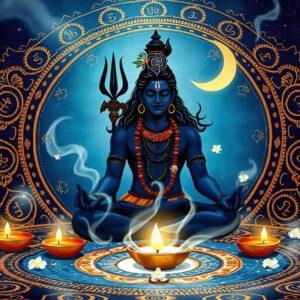
The Govindaraja Temple Brahmotsavam is a revered festival deeply ingrained in India’s spiritual heritage. Held at the Govindaraja Swamy Temple in Tirupati, Andhra Pradesh, this grand event attracts multitudes of devotees, marking a pivotal occasion in the Hindu calendar.
Historical Significance
Established by Saint Ramanujacharya in the 12th century, the Govindaraja Swamy Temple holds a rich history. The Brahmotsavam, honoring Lord Govindaraja, an incarnation of Lord Vishnu, stands as one of the temple’s most significant festivals. ‘Brahmotsavam,’ meaning ‘grand celebration,’ is believed to have been initiated by Lord Brahma himself to worship Lord Vishnu. This festival symbolizes the divine descent of the deity to earth, bestowing blessings upon devotees, and reenacts the celestial wedding of Lord Govindaraja and Goddess Padmavathi. The Brahmotsavam underscores the temple’s enduring legacy and its role in preserving Hindu traditions. You can delve deeper into the history of Sri Govindaraja Swamy here.
Rituals and Ceremonies
The nine-day Brahmotsavam is marked by distinct rituals:
- Ankurarpana: The ceremonial planting of seeds, symbolizing the commencement of the festivities and the renewal of life.
- Dwajarohanam: The hoisting of the Garuda flag, signifying the formal start of the Brahmotsavam and inviting the deity to preside over the celebrations.
- Daily Processions: The deity is carried on various vahanas (vehicles), including Garuda, Hanuman, and Gaja. These processions allow devotees to witness the divine presence and receive blessings.
- Chakrasnanam: On the concluding day, the idol is taken to the temple tank for a purifying holy bath, marking the culmination of the festival.
Each ritual is executed with meticulous precision, reflecting the deep devotion and reverence of the participants. Learn more about the Brahmotsavam timings here.
Significance of Vahanas
The procession of the deity on different vahanas is a central spectacle of the Brahmotsavam. Each vahana carries unique symbolism, enriching the spiritual experience:
Garuda Vahana
Garuda, the divine eagle and Lord Vishnu’s mount, embodies speed, power, and the ability to transcend limitations. This vahana represents the deity’s swiftness in responding to devotees’ prayers and his power to overcome obstacles.
Hanumantha Vahana
Hanuman, the devoted servant of Lord Rama, epitomizes devotion, strength, and selfless service. This vahana highlights the importance of unwavering faith and dedication in the spiritual path.
Gaja Vahana
Gaja, the majestic elephant, symbolizes wisdom, intelligence, and royal power. This vahana represents the deity’s vast knowledge and his benevolent rule over the universe. Find out more about the vahanas and their history in Brahmotsavams at Tirumala here.
Other Vahanas
Other vehicles, including Simha (lion), Surya Prabha (sun chariot), and Chandra Prabha (moon chariot), also feature prominently. Each day’s procession with a different vahana offers unique blessings to the devotees.
Cultural and Spiritual Experience
Beyond the rituals, the Brahmotsavam is a vibrant cultural spectacle. The temple is adorned with elaborate decorations, and the air is filled with the fragrance of incense. Traditional music and dance performances enhance the enchanting atmosphere. Devotees from across India gather, creating a tapestry of diverse cultures. The collective chanting of Vedic hymns elevates the spiritual ambiance. Participating in the Brahmotsavam is believed to cleanse the soul and bestow divine blessings. You can explore the cultural aspects of Durga Puja in Kolkata, which shares similar festive elements, here.
Preparations and Participation
Extensive planning ensures the smooth execution of the Brahmotsavam. Security, accommodation, and food arrangements are meticulously handled. Special seva (service) tickets are available for devotees wishing to participate directly in the rituals. Early booking is highly recommended due to the immense demand. Traditional attire and cleanliness are observed, and eco-friendly practices are encouraged. Discover the significance of Aarti, a key ritual in Hindu ceremonies, here.
Online Participation and Offerings
For those unable to attend in person, virtual participation is facilitated through live streaming of the events. Devotees can make online offerings and donations. Special puja packages and prasadam can be ordered for home delivery, maintaining a spiritual connection regardless of distance. Understand the significance of Pancha Pratishtha and establishing a divine presence here.
Poojn.in: Your Partner in Celebrating Brahmotsavam
Poojn.in, India’s leading spiritual and puja store, offers a wide selection of items to enhance your Brahmotsavam experience. From divine idols to puja accessories, we provide everything you need to create a sacred space in your home. Explore our collection of brass idols, incense, and other essential items. With convenient online ordering and reliable delivery, Poojn.in helps you bring the blessings of Brahmotsavam into your life.
Conclusion
The Govindaraja Temple Brahmotsavam is a divine celebration that harmoniously blends tradition, culture, and spirituality. The significance of the vahanas, the immersive cultural and spiritual experiences, and the meticulous preparations make this festival truly exceptional. Whether participating in person or online, the Brahmotsavam offers a profound opportunity to connect with the divine and seek the blessings of Lord Govindaraja. This sacred event not only honors the deity but also fosters unity among devotees, creating a memorable and spiritually enriching experience for all. Learn more about Laddu Gopal, another form of Lord Krishna, here.
FAQs
What is the Govindaraja Temple Brahmotsavam? The Govindaraja Temple Brahmotsavam is a grand annual festival celebrated at the Govindaraja Swamy Temple in Tirupati, dedicated to Lord Govindaraja, a form of Lord Vishnu. It is a major event attracting devotees from across the country.
When is the festival celebrated? The Brahmotsavam typically takes place in May-June, corresponding to the Vaisakha month of the Hindu calendar. However, the exact dates vary annually, so it’s best to check the official temple website for up-to-date information.
What are the key rituals? Key rituals include the Ankurarpana (seed sowing), Dwajarohanam (flag hoisting), daily processions with the deity on different vahanas, special pujas, and the Chakrasnanam (holy bath).
Why is it important? The Brahmotsavam is considered highly auspicious, symbolizing the divine descent of the deity to bless devotees. It is an opportunity to seek blessings, witness the rich traditions of the temple, and connect with the divine.
How can I participate? Devotees can participate by visiting the temple during the festival, attending the daily rituals and processions, and offering prayers. For those unable to travel, online participation through live streams and online offerings is also available.
What should I wear? Traditional Indian attire is recommended when visiting the temple for the Brahmotsavam. This shows respect for the sanctity of the temple and the cultural significance of the festival.


